This is an update of a previous post about Peter Jackson’s Hobbit films.
Yesterday, the Extended Edition of The Hobbit: The Battle of the Five Armies played in theaters as a prelude to its release on DVD/Blu-ray. And so with battle cries, the clash of weapons, and then a somber dirge, we have seen the trilogy-that-wasn’t-really-a-trilogy conclude. To be honest, I found it to be a curious admixture of satisfying and unfulfilling; the former because as a film saga, there is both excitement and sufficient closure, and the latter because it would have felt more complete, more “extended,” if Peter Jackson had deigned to drop in a few more looked-for elements from the books. But hey, war goats!
Spoilers follow for The Hobbit films.
Peter Jackson’s Hobbit films get a lot of flak for being overwrought, overlong, or “like butter scraped over too much bread.” Many of the criticisms are valid enough (I have some of my own), some are a matter of taste, and some, I feel, are simply misguided. My view, as a fan of Tolkien first and Jackson second, is that the naysayers are judging the films for what they’re not. They are not a cinematic translation of J.R.R. Tolkien’s singular novel but an adaptation in the truest sense of the word. Specifically, they are an adaptation of events in Middle-earth 60 years prior to the Bilbo’s famous eleventy-first birthday party, and that includes those from the The Hobbit and those implied from the Appendices of The Lord of the Rings.
To adapt something is to change, alter, or modify it to make it suitable for new conditions, which is where the problems occur for fans of a richly detailed story. No, not merely a story, a whole legendarium (Tolkien himself called it such) that lots of people care a hell of a lot about. The expectation seems to have been that Jackson should have kept to the books closely, should have told the story just as Tolkien did. But ultimately, that’s just not realistic and it would have made for a disjointed prequel.
It’s not like Jackson didn’t know what’s in the books; in addition to knowing them well, he was surrounded by Tolkien scholars, Elvish linguists, and other literary experts. Rather, he’s an uber-successful director, producer, and screenwriter who has to wrangle massive movie budgets and we’re not. He loves Tolkien’s work but had taken on the self-imposed, if herculean task of maneuvering a beloved tale through the Hollywood machine. Have you ever watched a comic book, novel, or even play adapted to film and thought, “That’s exactly how I would have done it”? If you have, then that’s amazing! If not, well, in this age of Hollywood remakes, reboots, and adaptations, why expect these films to be any different?
I want a faithful adaptation as much as anyone. But I am not a Tolkien purist about it because I think that Peter Jackson adding Tom Bombadil to The Fellowship of the Ring would have been as absurd as, oh, say, adding a scene in The Hobbit where Thorin & Co. enter the Lonely Mountain right after sending Bilbo in—you know, to go in quietly and do what they had specifically employed him to do. “That, Master Burglar, is why you are here,” Thorin says to him. So yes, that scene was too much. Do I love seeing what various chambers in Erebor might look like? The forges, the billows, the vats, the cavernous abyss of a great mine shaft? The fantasy nut in me says hell yes! But the Tolkien reader in me says no, not for a gratuitous and overlong action sequence, and not at the cost of undermining Bilbo’s quiet resolve.
Certainly not at the cost of losing this wonderful moment from the book:
It was at this point that Bilbo stopped. Going on from there was the bravest thing he ever did. The tremendous things that happened afterwards were as nothing compared to it. He fought the real battle in the tunnel alone, before he ever saw the vast danger that lay in wait.
Of course, it’s hard for any film to portray a character’s internal thoughts, which is all that moment is, but I think most of us would agree that Martin Freeman would have done an excellent job visually depicting Bilbo’s trepidation. Peter Jackson opted not to try this, and we can and must live with that. The book is not demeaned, but the movie is the lesser for it.
Likewise, Peter Jackson opted to keep Bombadil out of The Fellowship of the Ring, which it must be remembered had been his first foray into Middle-earth. And which, honestly, we’re still lucky even happened. And I agree with nixing Tom not because I wouldn’t like to see him or his oft-referenced yellow boots on the big screen—because that would be both fun and surreal—but because I don’t think anyone but die-hard book fans would have had the patience for him, his lovely but passive wife Goldberry, or his flamboyant, “Ring a dong dillo” self. Simply look at the numerous complaints of “too many endings” levied against The Return of the King. Jackson’s Fellowship would have faltered with the excess of Tom Bombadil (and even the barrow-wights, which I’d dearly love to have seen) and then millions of people would never have come to know or appreciate the greater works of Professor Tolkien. And the Tolkien Estate’s book revenue wouldn’t have increased by 1,000% (in the UK) as they did despite its utter contempt for Jackson’s meddling.
I reread all the books after seeing the films and I enjoying every unabridged word. Likewise, I’m happy to watch Peter Jackson’s six adaptations as a hybrid member of the audience, fully accepting that no one demographic can be fully satisfied. Among the many, you’ve got:
- Hardcore Tolkien fans who gripe at every change from the books (but still go see the films).
- New fans who loved the films and have now discovered the books.
- Action-adventure moviegoers who just want to be entertained but probably won’t ever read the books but “OMG look how badass that elf is with all the arrows and the shield-skating acrobatics and crumbling-tower-climbing and monster-bat-riding!”
- Kids, especially young girls who, according to the director himself, might be glad to have a relatively strong female character to root for (in Tauriel and Galadriel), where otherwise The Hobbit would have had none.
The point is that untold numbers of people have enjoyed all three Hobbit films, sometimes because of—and sometimes despite—their Jackson-expanded elements. Now that the Extended Edition of The Battle of the Five Armies is upon us, I’d like to consider the bigger picture.
I found The Battle of the Five Armies to be extremely fun. And a fine conclusion. And by that I mean that it’s a fitting capstone to the prequels for Jackson’s Rings trilogy. I never had qualms about The Hobbit being split into three films on principle. From the coming of Thorin to Bilbo’s home (July of the year 2941) to the return of Bilbo to Bag End (June of 2942), about 11 months pass. That story is told with three films. Meanwhile, from Frodo’s departure with the One Ring from Bag End (September 23, 3018) to all four hobbits returning to the Shire after Sauron’s defeat (November of 3019), about 14 months elapse. Again, three films. The span of diegetic time is comparable. Granted, there are more moving parts and political conflicts during the War of the Ring, but just as in the Rings trilogy, there is plenty happening behind the scenes during the quest for Erebor that Tolkien addressed long after writing it. The White Council moving against Sauron in Dol Guldur is one prime example.
It’s been said that “the filmmakers have wrung all they could out of the source material,” but I find that to be a lazy stab because it’s simply untrue. Indeed, that’s the irony. While three Hobbit films meant there should be room for some fleshing out of otherwise sparse details—the very thing people are complaining about, that he made a short book longer than they felt it needed to be—Jackson still didn’t actually cover everything. What he did do was garnish the films with more action and adventure. The Extended Five Armies is rife with monstrous combatants and innovative new war machines—trolls clad with gruesome-if-amusing armaments, dwarven ballistae that can and do shatter a hail of elven arrows, and bolt-firing war carts to name a few. It’s a true spectacle. Where Tolkien nerds might roll their eyes and wish for the story to get on with things, there is an audience for this and it does please.
And here’s an interesting development from the Extended Five Armies that really struck me: Before the orcs arrive, the Elves and dwarves do actually begin their battle at Dáin Ironfoot’s command. There is a clear loss of life on both sides, even though it’s brief. It’s heartbreaking to watch, a tragic consequence of the tension built up to that moment. You would think Azog, spying this elf-dwarf conflict from his command tower, would just let things play out! Regardless, the orcs arrive and with seemingly no hesitation—I love the unspoken certainty of this—the Elves and dwarves cease their fight with one another and engage the common foe. As if they had no heart to fight one another anyway. But both have an ancient hatred for orcs!
Battles and monsters are certainly Jackson’s forte, and the films cater to the movie-going crowd more than to the book-reading crowd. For those of us in the middle of that Venn diagram, it’s enough. At least in the new scenes, we are treated to seeing more of Thorin’s company engaged in the battle—including the unexpected removal of the axe blade in Bifur’s head! There is plenty of dwarf humor in the fray, but against the gravity of what’s going on, I found that to be quite welcome. Oh yeah, and Balin riding the war cart and peppering wargs with ballista bolts? Yes to that. This is part of a larger segment showing that the ride to Ravenhill to challenge Azog was considerably more difficult than we first assumed from the film’s initial release.
Some of the Extended moments weren’t quite enough to satisfy and they didn’t tie in well with previous ones. For example, we get only a few extra seconds of Beorn’s arrival at the battle and his ursine, orc-mashing fury, but nothing more. And though Gandalf has a few additional words for Thorin while the dwarf fumes at Erebor’s makeshift gate, I kept waiting for him to somehow mention Thrain, who he discovered in Dol Guldur in Desolation. If not in this scene, then in another. “Tell Thorin that I loved him,” Thrain had said to Gandalf. “Will you do that? Will you tell my son that I loved him?” Gandalf never does. It’s a small thing, but it would have made for better continuity to include.
I can abide almost any extension or stretching of characters and themes and battles, so long as they’re not completely antithetical to Tolkien’s ideals, but only if the existing story, including the appendices-based backstory, is exhausted first. There is much we never get to experience from the books. The animals at Beorn’s house; the Eagles and their eyries (and why they help at all); the drunk Wood-elves and Thranduil’s interrogation of the dwarves; the thrush and its world-saving delivery of vital information; the aftermath of the battle—all of these have been kept out. In the behind-the-scenes features of the DVDs, you can even see that some of these were filmed (such as all the captive dwarves being brought before the Wood-elf King, not merely Thorin), but never made even the Extended cut. Sadly.
But these are movies; they need to take into account a movie-goer’s patience (and bladder). Think of all that was removed from The Lord of the Rings, which has a full run-time of just over 11 hours. Given that, are you in the “What, no ‘Scouring of the Shire’?” camp or the “Nah, it’s fine as is” camp?
Still, in The Battle of the Five Armies, every second of screen time given to the character of Alfrid was one less that could have been better used developing the White Council’s purpose. Explaining who they are exactly, how their Rings of Power relate to one another, that sort of thing. We get only teasings of the world these immortal Elves and wizards come from: we glimpse Narya, Gandalf’s ring, and of course Galadriel’s. There is so much story in the rings that never comes out. Whereas Alfrid is an unnecessary, cartoonish weasel. In any case, it seems the Master of Lake-town’s fate in the book has become Alfrid’s fate in the film and the dragon-sickness gets to him. In the Extended cut, Alfrid does get his comeuppance. While I’d prefer he simply vanish to starve in the Waste with his stolen gold—but how do you show that in a film? (you can’t)—for some it may be satisfying to see Alfrid meet his mouthy end.
The White Council’s ousting of Sauron from Dol Guldur still feels the most truncated, even in the Extended Edition, if only because we know there’s plenty of lore behind it. It has a direct bearing on other events, which Gandalf touches on briefly later and it explains why he stirred Thorin to his quest and nosed around Dol Guldur in the first place.
Per Appendix B of The Lord of the Rings:
Among many cares he was troubled in mind by the perilous state of the North; because he knew then already that Sauron was plotting war, and intended, as soon as he felt strong enough, to attack Rivendell. But to resist any attempt from the East to regain the lands of Angmar and the northern passes in the mountains there were now only the Dwarves of the Iron Hills. And beyond them lay the desolation of the Dragon. The Dragon Sauron might use with terrible effect. How could the end of Smaug be achieved?
I enjoyed seeing the ringwraiths in their more spectral form, even if their inclusion via the High Fells of Rhudaur were an addition. This is a prime example of where I don’t mind Peter Jackson’s tinkering; it was never made clear by Tolkien where the Nazgûl would have been during this timeframe. No harm, no foul, why not see them again? That said, more spellcasting and less wizard-fu in the Dol Guldur skuffle would have been preferred, but it’s still gratifying to see Galadriel finally invoke some epic, Silmarillion-flavored might. She will one day return there, after all, when the Shadow is defeated.
Also from Appendix B:
Three times Lórien had been assailed from Dol Guldur, but besides the valour of the elven people of that land, the power that dwelt there was too great for any to overcome, unless Sauron had come there himself. Though grievous harm was done to the fair woods on the borders, the assaults were driven back; and when the Shadow passed, Celeborn came forth and led the host of Lórien over Anduin in many boats. They took Dol Guldur, and Galadriel threw down its walls and laid bare its pits, and the forest was cleansed.
But I do wish her bearing was brighter and less dark-queen creepy, which is clearly meant to gel with her Fellowship manifestation. In Five Armies, she is not being tempted by great power, she’s using her own. I think the visual connection was too much handholding. Likewise, I wish her voice was not once again layered and pitch-dropped—Jackson’s sound crew, having proved themselves throughout all six films, could have done way better than use that cheap trick.
Still, in the Extended cut, we now get to see her utterly obliterate Gandalf’s orc jailor—who seconds before was ready to cut the wizard’s ring from his finger after beating on him. Indeed, the orc was strangely informed: he knew of the Ring of Fire and demanded to know “Where are the others?” That is when Galadriel arrives and makes short work of the orc.
Saruman himself is underused throughout the trilogy, though it was a joy to see the much-aged (and now late) Christopher Lee return to the role. He is the head of the White Council, and though he kicks serious Nazgûl ass in Five Armies, he seemed more horrified than intrigued at the sight of the Enemy, who he was charged to oppose from the start. I was hoping for deeper insight into his own corruption and eventual betrayal. In the canon, he was already desiring the One Ring for himself at this time and had discovered only two years prior that Sauron’s servants were searching the Anduin near Gladden Fields. Which is why he’d finally agreed to move against the Dark Lord, to keep him from finding the One first.
“Leave Sauron to me,” seems to be the only hook we get. But anyone who’s read more about Saruman knows that he regarded Sauron as a rival, not merely an enemy, at this point in time.
As for Tauriel and Kili, this is all there is to it: In An Unexpected Journey and only in the Extended Edition, we see Kili eyeing an Elfmaid in Rivendell, so we know he’s prone to elven interests. Then in Desolation, he meets Tauriel and actually falls for her (as much as a dwarf can in so brief a time) and is subsequently saved by her efforts. Then in Five Armies, it all comes to a head and one dies trying to save the other.
I’ll say two things about this subplot then leave it alone, since much has already been said and because it’s a small matter compared to the rest of the story.
Tolkien’s Elves, while portrayed quite differently in the films than in the books (a topic for another time), are still presented as a tragic, if powerful race. To me, the tale of Kili and Tauriel is less about an Elf and dwarf romance as it is the adversity that lies between an immortal and a mortal. That is a theme that Tolkien cared much more about and he played with this idea several times, in Beren and Lúthien, in Aragorn and Arwen. Even Elrond and his brother Elros were given the choice of mortality or immortality; Elros chose the doom of a mortal Man (and surprise, chose a mortal wife), while Elrond chose immortality. The brothers were therefore parted by the passage of thousands of years.
There is also precedence for a rare fondness between Elves and dwarves despite their ancient and Silmarillion-documented feuds of the past. In the Rings trilogy, not only do Legolas and Gimli forge an everlasting friendship with far-reaching effects, but Gimli is powerfully smitten by the beauty of Galadriel and it changes him deeply. The dude won’t shut up about her sometimes, it’s awesome.
And it happened in a moment, at their first meeting. Like…Tauriel and Kili, though of course one is romantic and the other is not. Against all these, the cinematic contrivance of Tauriel and Kili’s brief but unexplored love is nothing to fret about. Yes, it’s annoying to see an Elf lose her head, teenager-style, in the midst of a great battle—and more so because she’s one of the few female characters—but she’s still the only Elf pushing to oppose the orcs because it’s the right thing to do. Even Legolas would not have without her urging, and daddy Thranduil merely covets gems. (Side note: In one podcast interview, Hobbit writer Philippa Boyens clarified that the white gems that Thranduil wanted to badly had been commissioned for his wife, before her death, and that is why he is so fixated on his claim. It’s all he’d have of her, since Legolas tells Tauriel that his mother’s body was never found. To immortals such as Elves, memory can be everything. Even Boyens wasn’t sure if Peter Jackson would add this detail into the Extended cut, and in the end, he did not.)
So you may feel the Elf-dwarf romance feels forced, and the alleged affection between Legolas and Tauriel is also hard to buy into—in part because the films have made Elves colder than their literary counterparts—but it’s also harmless. So a character with little personality in the book (Kili) is given feelings for a character nonexistent in said book (Tauriel). Big deal. It’s not like Jackson gave Bilbo a girlfriend. Thankfully.
Honestly, I’m just happy to see female Elves, period, especially in battle. In the massive ranks of armored and militant Elves—at Helm’s Deep or even in the Last Alliance prologue—are there any? I did manage to glimpse a few female warrior Elves among the masses in Five Armies, though. Good.
The fact is, the biggest portion of the trilogy are the adventures of the titular hobbit, and Martin Freeman’s Bilbo remains the highlight, diminished only in scenes where he’s upstaged by the actions of others. I was quite content with his role in Five Armies, since the “Thief in the Night” sequence was more or less faithful to the book and his involvement in the battle itself was extended only lightly. Bilbo’s parting words with Thorin as the dwarf lies mortally wounded were meaningful to me, if much too abridged—but then that’s generally my only complaint. The Extended cut, at least, does reveal the funeral for Thorin, Fili, and Kili, as well as the crowning of Dáin Ironfoot. Though it is brief, it brings more closure to the story.
If you watch the films and then read the corresponding events in the book, you’ll find that Tolkien’s storytelling method has a curious, tell-don’t-show chronology to it—something he did in The Lord of the Rings but perhaps not as arbitrarily as in The Hobbit. I’ve heard it complained that Fili and Kili’s deaths were “much better” in the book by naysayers of the film. To that I say, there was no scene at all in the book relating their deaths, merely a past perfect, after-the-fact summation of what happened. All we get is:
Of the twelve companions of Thorin, ten remained. Fili and Kili had fallen defending him with shield and body, for he was their mother’s elder brother.
So I for one am grateful for the things we do get to see brought to life on the big screen. The Rings trilogy was full of satisfying “off screen” moments from the books brought on screen, like the Ents’ assault on Isengard and Boromir defending the hobbits from orcs. Hell, to me Dáin Ironfoot’s portrayal in Five Armies was enjoyable even CGI’d as he was, and seeing an army of dwarves gratifies the D&D freak in me. Dáin, like Bolg, like Thranduil, like most of the dwarves, are given personalities Tolkien doesn’t take the time to do.
And that’s fine that he didn’t. It was a single book he wrote before launching the true enormity of Middle-earth. Tolkien was a revisionist, and even went back and made changes to The Hobbit once he started to write The Lord of the Rings. (In the first edition of The Hobbit, Gollum bets Bilbo his magic ring if the hobbit wins their riddle game—imagine that!) But Tolkien was content merely to bridge The Hobbit with Rings in other ways and not rewrite everything from the start.
2001’s The Fellowship of the Ring is a miraculous, groundbreaking film and each of Jackson’s installments since have, in spirit, style, and Tolkien lore, been like a carbon copy of the previous one, so that 2003’s The Return of the King was still excellent and felt close to Fellowship, but 2014’s The Battle of the Five Armies is certainly a far cry from it. Yes, it’s far more flash and action than rich storytelling and certainly bears even less resemblance to the source material, but it is at least consistent with its own vision of Middle-earth. And that’s what they all are: the vision of one man (Jackson) who stands at the vanguard of an army of talented artists and filmmakers. Because of that army, it’s still a hell of a lot of fun to experience. And Howard Shore’s score still somehow legitimitizes it, just like a John Williams score and a lightsaber sound effect can still, just for those choice moments, invoke nostalgia in even the crappiest Star Wars film.
The Hobbit trilogy is not perfect, of course not. There are numerous things to pick at. The stone giants sequence in An Unexpected Journey was needless showing off of CGI and presented a hazard to the characters only vaguely suggested in the book. The barrel-riding scene was turned into an action sequence that downplayed Bilbo’s day-saving role in their escape. But at least the stone giants and the barrels are in the book. Some of the added dialogue just doesn’t work. Fili telling his brother “I’ve got this!” at Ravenhill is gratingly anachronistic and not remotely Tolkien-esque. Though a pretty mild offense, I found Saruman referring to the Necromancer as a “human sorcerer” disappointing because the word “human” is never used by Tolkien to refer to Men in the books. Legolas and Tauriel reaching Gundabad and returning again in so short a time undermines the length of Bilbo’s entire journey. Jackson certainly played fast and loose with geography.
All the birds and beasts have been de-anthropomorphized. The Eagles did not speak, and neither does Roäc the raven nor the thrush. Beorn’s sheep, dogs, and pony friends don’t serve Thorin and Co. their meal as they do in the book. But these things wouldn’t exactly be in keeping with The Lord of the Rings, anyway—neither Tolkien’s nor Jackson’s.
When I first saw An Unexpected Journey, I loved it but I have learned to accept the things that didn’t play out more like in the book. Why, I fretted, didn’t they use the Great Goblin’s actual dialogue from the book? Sure, add some new lines but don’t replace what was there wholly. But I’ve learned to let it go. As J.R.R.’s own grandson has said, the films “kind of have to exist in their own right.”
Repeated viewings of all six films continue to impress me, and watching the making-of featurettes on the Extended Edition DVDs you can see some light shed on reasons for the changes even if they’re not what you’d have done. For me, I pine not for a perfectly faithful translation of the books but for the additions that could have been. The opportunities for greater context were there, right under Peter Jackson’s nose. We’ve met Radagast (who totally would have been given at least a cameo in Fellowship if Jackson has made the Hobbit films first), we’ve heard of the “two Blueses,” and we’ve seen the White Council in action. Why not use all that to show, even just a little, what Gandalf really is, why he’s constantly prodding everyone to oppose Sauron, and how he had the power to “rekindle hearts in a world that grows chill.”
Why not address the Nine, the Seven, and the Three? Especially the Seven, since the fate of Durin’s folk, their greed, and Sauron are all related? It was Sauron’s work that fanned the gold lust of the dwarves through the Seven Dwarf-rings. In the Extended Desolation, some time is spent showing how Thrain once had the last of the Seven but how it was cut from his hand by Azog. Why show the rings at all if we’re not going to learn something more of their power?
But alas, that would not have been done so easily, as a lot of that lore comes from The Silmarillion and the Tolkien Estate has not yielded that license. Not to mention the awesomeness of The Unfinished Tales, which reveals all kinds of good stuff about the Istari—and Saruman specifically.
The films are not the books and shouldn’t be judged as such. If they’re not what you hoped for, fair enough. You can’t please everyone, but don’t try and take them away from those they did please. As old John Ronald Reuel himself wrote in his Foreword to the Second Edition of The Lord of the Rings:
As a guide I had only my own feelings for what is appealing or moving, and for many the guide was inevitably often as fault. Some who have read the book, or at any rate have reviewed it, have found it boring, absurd, or contemptible; and I have no cause to complain, since I have similar opinions of their works, or of the kinds of writing that they evidently prefer.
Personally, I’m pleased with any franchise which shows, however briefly, Belladonna Took’s son as a small child, merrily play-battling with Gandalf the Grey, a symbolic and touching moment for all that would follow. Not only does it show that a mighty Maia spirit was fond of the simple Shire folk, it also shows why he would select one of them in particular to turn the tide.
Jeff LaSala can’t wait to read The Hobbit to his son, who is much too young to realize how nerdy his dad is. For now, they’ll just be pointy-eared denizens of Middle-earth together for Halloween.










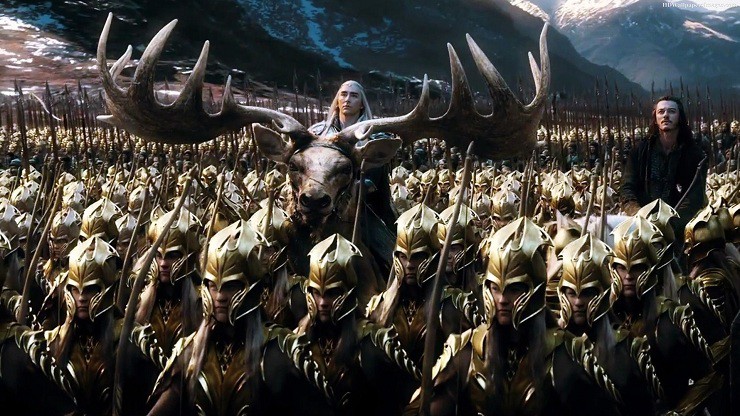
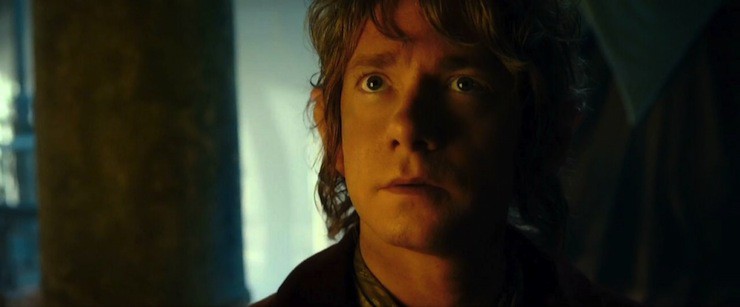
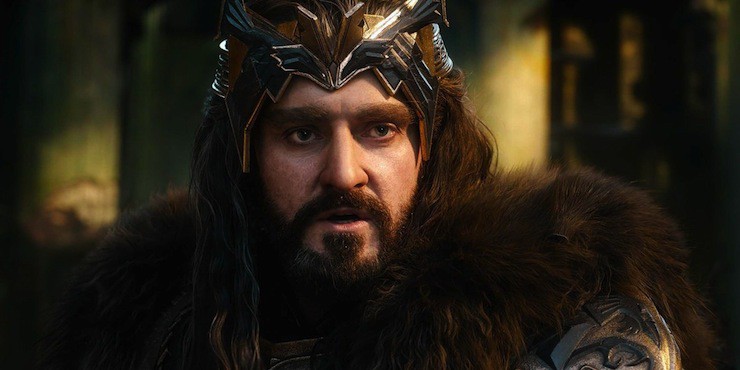
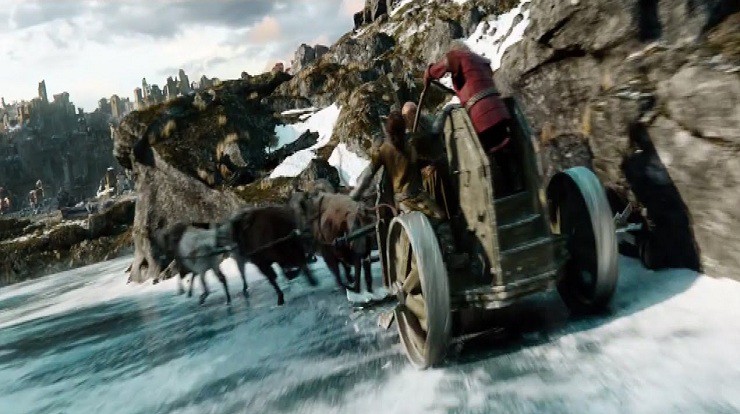
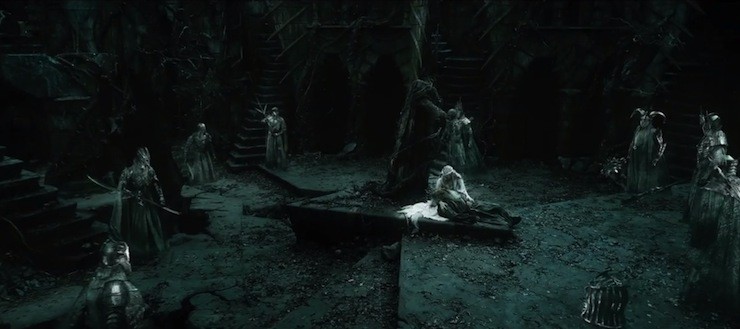
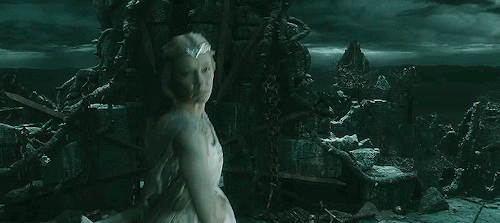
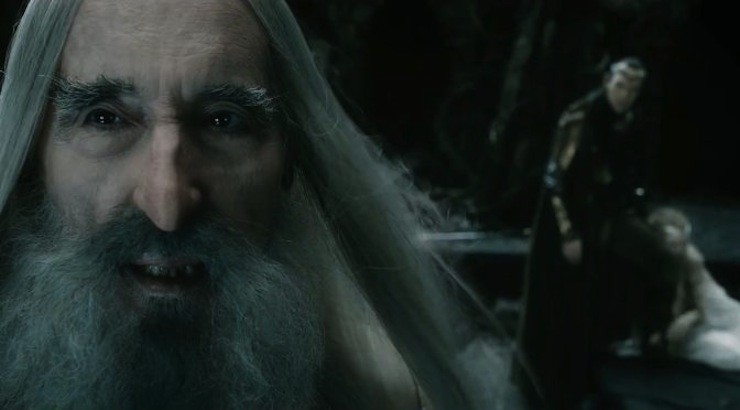
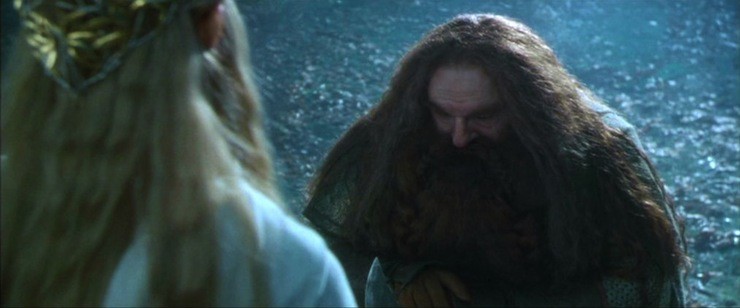
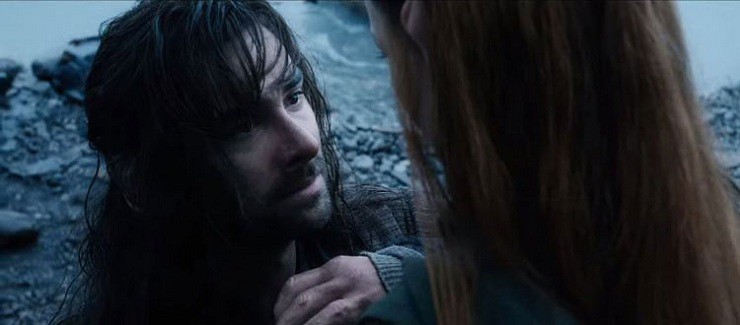
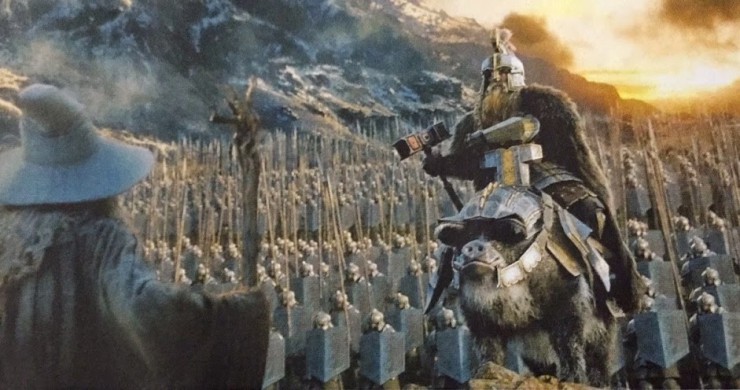
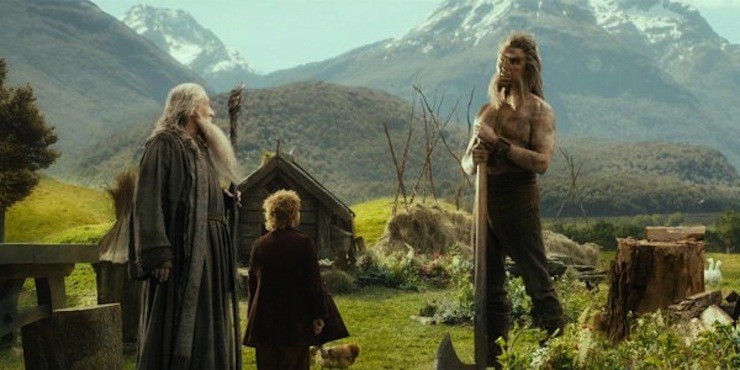
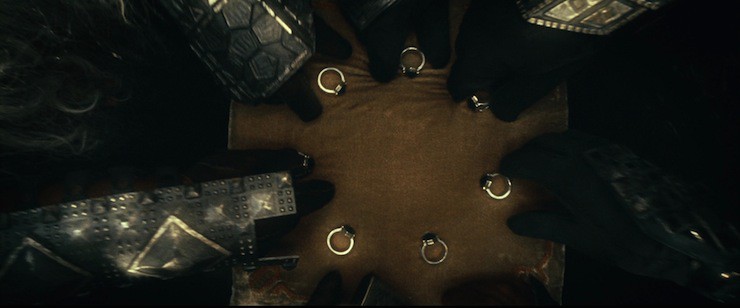
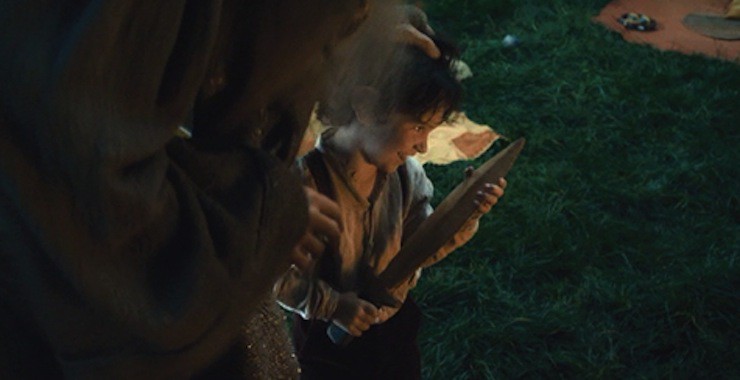
I know Tauriel was a big complaint, and I agree. But not for her being an added-in female character. The whole point of Gimli and Legolas’ friendship in LOTR is that true friendship between Dwarves and Elves is so rare throughout their thousands of years of shared history that it is worth remarking on. If Fili fell for Tauriel and she just sort of went about her business being an ethical badass, I’d be 100% on board. But (a) they fall in love, which undermines the stated uniqueness of Gimli and Legolas (not to mention the close ties both the dwarves and the elves have with one another; neither would be likely to find their friendship super unusual given how close both are to Tauriel and Fili) and (b) Tauriel then just turns into another accessory to a male character.
If the point of Tauriel was to have a strong female warrior character (definitely a worthwhile aim), then why undermine it? And if the point was to provide some faux-thought provoking love interest for one of the dwarves, then I can’t possibly imagine why she needed to be added in to the movies in the first place.
Great article. I have been a fan of Tolkien’s works since I was 9 & used a $5.00 bookstore gift certificate that I got at Christmas to buy the green hardback edition of The Hobbit – which I still have.
I have thoroughly enjoyed Jackson’s Middle Earth movies. Were they perfect? No. Did they have flaws? Yes. Were there some things that I wish he had added/kept? Yes. But I wasn’t looking for, nor wanted honestly, a literal translation of the books. That was the trouble the Harry Potter movies got into with the first two movies, to my mind.
When I first heard that Jackson was doing The Hobbit & was planning on three movies I naturally assumed that he’d be adding parts from the appendices and possibly Tolkien’s other notes (e.g., Unfinished Tales). I was hoping he’d delve into the beginnings of the romance between Arwen & Aragorn that starts up around the time of Bilbo’s trip. Seemed to be a perfect fit to this armchair screenplay writer.
Still, I thought Tauriel was a nice addition and didn’t mind her budding relationship with Kili all that much; they both made it work I thought. Interestingly, everyone’s instant love for Fili & Kili after the first movie was my “Red Wedding moment” if you will. I knew Jackson was building up the brothers to make their deaths far more meaningful & personal to the film goers; and it did.
I could go on but you’ve spoken far more eloquently about this that I could – and have brought voice to my thoughts, which is nice of you. ;-) So I thank Tolkien for writing as he did & allowing us to share in his vision of Middle Earth & Jackson for bringing forward the best adaptation of Tolkien’s works.
Kato
Great read – thank you Jeff.
I’m sorry. I watched Jackson’s first Hobbit movie, and simply could not move past the absolute rubbish and nonsense that was added. Giant rabbits! Pulling sleds! Chased by the most unconvincing CGI animals I have ever seen!
Then, as mentioned, the stone giants! No!
Then.. *then*.. we have perhaps the most aggravating bit in the escape from the Goblin King. Get your slapstick out of my movie!
Tauriel only bothered me at the end. Building her character up that way, and then making her a damsel in distress that needs to be rescued not once, but TWICE, once each by the men pining for her, made me laugh out loud, and I resented the intrusion.
Quite frankly, i was expecting that Tauriel would die trying to save Kili, and that would give Legolas a more personal animus against dwarves than just the cold distrust of one species over another. Missed opportunity to retroactively strengthen Legolas and Gimli’s friendship in Rings.
Thanks, guys.
I wouldn’t put Tauriel in quite the damsel in distress status. She kicks a lot of ass, and in battles there are gives and takes. If you fight alongside someone you’re both saving each other just being there. She showed up and took Bolg on precisely because she was going there to save Kili and heck, he might have died earlier without her arrival. In the end, Bolg was the superior warrior to both of them.
So I wouldn’t dismiss her so quickly. Had she not taken initiative to go to Ravenhill, neither would Legolas. That was HER call. You know, the “damsel in distress.” Without both Elves, Thorin and the others would have been thoroughly outmatched.
But sure, I’d also imagined a different end and what we got is okay but not great.
While I understand the time limits for theatre editions of films surely extended DVD editions can be allowed to run to otherwise unreasonable lengths? It seems a shame to have footage that was good enought to use in the making of sections not incorporated into the extended version.
@7:
There are limits to the space of physical media, without forcing the viewer to switch disks. About 4 hrs for DVD, and that leaves no room for anything else on that disk. You have to lower the picture quality to fit more on.
For Blu-ray, its more fluid, but the longer you go, the lower the quality, again. And for streaming, and downloading… well, there are bandwidth concerns, server size issues, etc. Amazon, for one, charges fees for downloading media, and takes it out of what they pay the content producers.
When it comes to Middle-earth, to me, more is more. So I’d love to see more than what we’ve been given, especially I know some of it was developed. But it’s true, you can’t tack on too much because then we’re straying from feature film into TV show territory (which I wouldn’t want to happen). In the end, there doesn’t need to be film footage to match everything in the books anyway. Nowhere is more glorious than our imaginations, after all.
As you note, there is nothing inherently wrong with adapting the Hobbit so that it fits directly into the aesthetic and tonal world of the LOTR film trilogy. Something wonderful could have been made from such an endeavor, and like you say, there is plenty of source material to work from both in the text and the appendices. Jackson didn’t fail in his motivations, but he clearly and completely failed as a filmmaker in these three movies. The lack of grace, of subtlety, of courage in the choices he made as a director is evident in every frame. I can only guess he fell prey to George Lucas-disease, where the answer to “what should go here?” is “More, more and more!”
It’s a horrible shame, because he succeeded so brilliantly in the LOTR in creating a world that had weight and history and a sense of internal logic to its reality. The Hobbit films seem both rushed and overlong at the same time, and hampered by set pieces that exist for their own sake and which carry no emotional weight, as useless as interstitial scenes in video games. I agree with you that adapting the Hobbit “straight” and “faithful” would have been both a challenge and perhaps even a mistake, but I think a more courageous filmmaker, one less sure of the past successes and less prone to visual overabundance could have tried to bridge those two perspectives more cohesively–adding a new layer to the filmic world, rather than just pasting some more on to the one that already exists.
Just wanted to let you know I favorite this and am looking forward to reading it once I get my hands on the EE :) Although sadly it seems from the intro it’s not going to be what I want it to be. I really enjoyed the first Hobbit movie but the second two just…didn’t do it for me and left out a lot I wanted to see, especially in the epilogue.
I’m pretty sure that the extended editions of LotR are spread over multiple disks. It’s been a while since I watched them though.
What struck me after seeing all three parts of The Hobbit was this: I quite enjoyed the movies for what they were, and I respect the choices Jackson made even if they weren’t always in accord with those I might have wished for.
And at the same time: I can now think back on the Rankin/Bass version of The Hobbit, which I saw at a fairly impressionable age, and find it equally wondrous in its own quite different way. The two executions are enormously different in scale, in production style, and in approach — but there are things to value in both, and both show a tremendous respect for their source material even as they express it in different ways.
“He loves Tolkien’s work but had taken on the self-imposed, if herculean task of maneuvering a beloved tale through the Hollywood machine.”
My feeling is that this wasn’t self-imposed, but studio-imposed, once Guillermo del Toro opted out of the director’s chair. I also feel like the move to 3 films wasn’t an artistic choice, but economic. Where Lord of the Rings was clearly a labour of love, The Hobbit feels like a labour of “well, we need another billion dollars in the bank”. As a result, my sense is that this was less about manoeuvring the film through the Hollywood machine, as simply collecting the sausage that came out the back end of the Hollywood Machine.
Interesting read…as a life-long Tolkien fan, I was ready to bail on this series after Unexpected Journey, which (for me) drifted too far from source material and had some truly silly action sequences. I went to see Desolation not expecting much, and it met my minimal expectations. However, when Battle came out, I attended the three movie marathon and found myself enjoying the movies much more than I did originally – the combination of the three movies took the first two disjointed parts and made them fit into a whole package, one that I enjoyed for the sake of what it was. The Hobbit movies certainly don’t rise to the level of the LOTR movies and have all the problems I mention above, but they do a good job of telling the overall story and making it entertaining.
It’s nice to hear someone else mention the issues with geography in the Hobbit and LOTR movies. As an example, the geek in me must admit that one of the things that always bothered me most about ROTK was the concept of the cities of Osgiliath and Minas Tirith being so close together! Tolkien did an amazing job of fleshing out a huge world in his books, and a couple scenes in the movies capture this. However, there are also far too many scenes and storylines in the movies that directly contradict this and make the world feel far too small.
I’ve been a fan of Tolkien for almost 40 years. I read the books when I was a young lad. I trekked through the dark streets of downtown Spokane, WA to the Magic Lantern theater to go see Ralph Bakshi’s rendition in 1978. The book got me into RPGs and gaming in general. It formed my opinion of the fantasy genre which still holds fast today (I rarely read high fantasy anymore because I can just re-read The Hobbit/LotR, most everything else is derivative. I LOVED PJ’s version of The Lord of the Rings. Masterfully done, perfect blend of live action vs. CGI, just the right length, very good and acceptable changes.
Then came The Hobbit movies. Bloated abominations of senselessness. Hidden somewhere in all the fakery, lifeless CGI nonsense, and ridiculous changes/additions is my beloved Hobbit. I wrote reviews of all THREE movies on my website, flaying them to pieces for being overwrought cash grabs. Bits and pieces of the movies are great. But as a whole, as a stinking TRILOGY, they are very bad films and even a worse translation of Tolkien’s classic.
YMMV…
Yeah, one of the issues I had with Tauriel was her relationship with Legolas specifically. Legolas’ jealousy of Fili now seems to have reconned implications vis a vis his relationship with Gimli: ie, that his initial hatred and distrust of dwarves is because of some previous unrequited love and jealousy. That makes the character just seem more petty than it needed to be.
Well said, John C. Bunnell. Both the Rankin/Bass Hobbit and Bakshi Lord of the Rings had plenty of departures from the source material—just like Jackson—but they still retained artistry and spirit, and I found they all still somehow managed to feel like Middle-earth.
And jms1969, yes, exactly. I think real solid fans of the book have to acquire a taste for these movies. Once you accept that they’re going to be different in some significant (but hardly all) ways, they become much more enjoyable. The two can co-exist. As I said in an earlier article:
Concerning Hobbits, On-Screen and Off: Why Jackson and Tolkien Can Peacefully Co-exist
Jackson doesn’t need online defenders. He has his money.
I can deal with changes needed because of the medium or to broaden the audience (Arwen), but to change something only because it is an “adaptation” or because one has become giddy with power?
Osgiliath almost ended my Tolkien movie watching, the Unexpected Party did.
I am sure that these similar changes did not bring a single new ticket or disc buyer.
Thank you for such a wonderful read, Jeff. I really enjoyed it, and I agree with a lot of what you are saying.
The Hobbit trilogy is not perfect, in some ways not at all (I also hoped for a Thrain reference and Bilbo planting the acorn in Dale), but I love these movies so much. Especially the quieter moments with Bilbo and Howard Shore’s wonderful theme.
I am also thankful for having experienced this trilogy now, as I was not old enough to enjoy the previous trilogy when that was released a decade ago. Meeting new friends at TheOneRing.net has been wonderful, and Jackson’s production videos and Extended Editions have inspired me to learn more about filmmaking and screenwriting.
I agree with most of this review. When I was 15 I probably would have been less forgiving of the ‘additional content’ and various changes, but you get older and maybe you start to look at things from the filmmakers point of view. He had to make watchable and enjoyable movies, first and foremost. Nothing really offended me as a Tolkien fan, on that score I think Jackson succeeded (although as with the LOTR movies, you do have to wonder why Jackson changed things that had perfectly fine, even superior, equivalents in the book.).
The reason I think the Battle of Five Armies finally failed where the other films to various degrees succeeded was in the actual filmmaking. Here Jackson crossed the line with battle CGI. Since Fellowship its always been a balancing act of how beautiful and somber most of the movies looked throughout with how ridiculous and lowbrow the (bloated) battlescenes increasingly became… and not coincidently how much more visibly CGI’d they became. The Cave Troll scene in Fellowship worked because it was short and sweet and focused more on the characters reactions to the troll than to an extended scene showing the troll doing a ton of ‘cool’ things. Ive argued every one of these movies was worse than the one before it, and i stand by that, and its because of this reason. Jackson has progressively fallen so in love with his effects and how it can make impossible things happen that he has lost sight that somewhere around the Battle of the Pellenor Fields he passed into the realm of ‘cool for cools sake’ and finally into ‘now this is just silly’. IE- 40 minutes of Legolas running around the Battle of 5 armies constantly breaking the laws of physics. Even an elf cant run up a falling rock, the unconscious brain sees this kind of nonsense and scoffs, whether you want to buy in or not.
I liked the movie alright, the disapointment is that had Jackson shown the restraint he displayed in FOTR and TT, it could have easily been a REALLY good movie.
We’re on the same page, MB. As I said above, with each movie, we’ve seen things drift further away from Fellowship. Battles is a good movie, I feel, and I even genuinely enjoy the CGI battle, but when you then compare it against Fellowship it feels a bit less real. No doubt. It’s a good movie. It could have been a better one.
I will mostly just repeat what I had to say in Kate Nepvue’s re-read of the Hobbit and the movies…
Of all the things that Jackson stuffed into the movies (and there definitely should have been only two!), Alfrid is the absolute worst!! I thought at first that Tauriel was going to be the worst addition but, boy, was I wrong.
And speaking of Tauriel, she did not fall in love with a dwarf as Kili (and Thorin, of course) were NOT dwarves but undersized humans! Given the visual characterization of all the dwarves in all 6 movies, puting a little (very little in Kili’s case) facial hair on Thorin and Kili does not make them dwarves.
I also got really tired of surfer-dude/Road Runner/generic cartoon character Legolas, who should not have been in the Hobbit movies at all.
Overall I felt mostly disappointed in this latest movie, although I can’t really point to any one thing that made it disappointing. I do remember my first thought when the credits started to roll at the end was that they should have said “Very, very loosely based on Tolkien”. Maybe the extended edition and the eventual Blu-Ray box set will go down better. I hope so.
Added: I never expected a truly faithful translation of the book into a movie (or two: NOT THREE) as that is almost literally impossible but too many of the changes Jackson made were just too far out there.
As for the extended version, it seems that this added more than the other two, but there was still a lot left out. I wonder if next year will see the Blu-Ray box set come out with still more added material?
In overall, I agree with Jeff’s article (it really is a good one) and what Kato added in the comment. I am a long-time fan of Tolkien’s work, but I also love the movies. Feeling like a traitor to myself for telling this, but the Hobbit trilogy did not match the original LOTR one, and even I found it hard to overlook Legolas running up the falling rocks, my favourite character from the first pages he appeared on as he is. Nevertheless, when taking them not as the book’s literal retelling but as PJ’s vision of it, I love them. And I am really happy the EE will have a scene of the funeral, however brief, this was the only thing I was keeping my fingers crossed for. These three deserve it. If it would have been left out … there wouldn’t have been a proper closure for me.
I have to admit, like anthonypero @5, I, too, half expected Tauriel to die. I have nothing against the character, but I thought PJ would use it to explain Legolas’s initial hatred of dwarves in the FOTR and why there is no mentioning of Tauriel later.
One comment from Kato also made me wonder if the people (me included, boy, am I smitten by them) would have been taken to the Durin brothers so quickly if the casting would have been different?
Have preordered my copy, Amazon says it should arrive in time for Christmas. It’s ok. I have patience, I can wait.
As I said, I’d come back and read this once I saw it; we ordered it for Christmas.
Sigh. Usually I like movies a lot better the second time around, and with the LotR/Hobbit movies, the extended editions help improve them. This may be the first time this hasn’t happened; if anything, the extended edition was a bit worse, because it was just more of the SAME STUPID CRAP I didn’t like from the theatrical version (more ridiculous battle scenes, a really bizarre death scene for Alfrid, etc). I had this whole list of things I was hoping to see in the extended editions, especially stuff that gave it a better conclusion and tie in to Lord of the Rings, to go along with the ‘Hobbit as LOTR prequel’ approach. But they only did two of them, which is to show Dain as the king and Thorin’s burial with the Arkenstone (in the same scene – which by the way, in my opinion should have been in the original movie and they could have cut more stupid battle scenes out. But then there’d be nothing good for the EE, I guess, ha), and I think maybe there was some more of the White Council at Dol Guldur (more Galadriel kicking ass, YEAH), but nothing that substantial.
Honestly, I think the movie worked a bit better when I just realized this is basically Peter Jackson’s last movie in this world and he’s just going to pull all the ridiculous stops he can, and TRY to have fun with it. Because that’s what he does – even if it totally overwhelms the movie and some of the really amazing quiet/character moments. I mean, pretty much every single scene with Martin Freeman was completely out of the park, and Richard Armitage was pretty great too. The movie needed more of that.
I also can’t get over the ridiculousness of the R rating. Do we really need an R rated version of a children’s book? FOR REAL? I feel like PJ should have taken that as a sign that he went waaaay off the rails with all the battle scenes. They aren’t even interesting. We already for the most part know who is going to live and die so it’s not like there is a ton of suspense…I don’t understand why watching exploding orc heads or what have you is entertaining. Usually I’m just waiting for that stuff to be over so we can get to the interesting stuff.
Ugh. Anyway, usually the EEs are pretty good, and there are some really interesting scenes in there that flesh out the story and provide some more depth, but this one was really a disappointment. It’s kind of a shame it ended this way, because the Lord of the Rings movies (aside from Two Towers; I just can’t forgive Faramir and the Osgiliath detour) were sooo good. And even the first Hobbit movie was pretty good and I don’t recall having many serious complaints about it. A few eye roll inducing moments from the river battle maybe, but that’s it. We still enjoy watching the commentaries and featurettes and it’s obvious that Jackson has worked tremendously hard on these movies and even loves/knows the works. He just must have a very different idea of what is entertaining than I do.
But man, when compared to some of the amazing scenes towards the end of Return of the King (The Ride of the Rohirrim – a great example of a non ridiculous battle scene, the scenes with Frodo and Sam on Mount Doom, Frodo at the Havens and Sam’s homecoming) – these had me sobbing in the theater when I first saw them, and even today, watching them, I get tears in my eyes. THIS is what he is capable of, so it’s so disappointing when the Hobbit fell so short of the mark. He obviously knows how to do really powerful scenes and hammer home those personal relationships and moments of character development that MAKE the film, combined with epic action and thrilling/exciting moments. The Hobbit movies definitely had moments like that (some of the scenes with Bilbo were truly moving and made me a little misty eyed) but there was so much filler. The music is good at least – I still want the soundtrack. As my husband says, he can forgive the Tauriel/Kili romance because it gives us their love theme (which is truly gorgeous), haha.
I don’t disagree too much, Lisamarie. The filler scenes in the EE of Battle were fun to me but I’d gladly have exchanged them for more aftermath, and more importantly, a clearer leave-off from Dol Guldur. In the books, Saruman already desired the One Ring for himself at this point in time—he agreed to let the White Council drive Sauron in order to keep Sauron from finding it—but it’s clear from the making-of appendices that in this version of the timeline, Saruman was not yet corrupted.
I actually got the opposite impression from the movies – I saw some of Saruman’s veiled comments that he was definitely already corrupted and wanting to find the Ring for himself. I know they played fast and loose with some of the other elements of the timeline (IIRC, the Ringwraiths weren’t actually active yet at this point in the books).
But I haven’t watched all the appendices yet, so if their intent was to show that Saruman wasn’t corrupted yet, they did a crappy job, lol. Perhaps he wasn’t full bore evil and was telling himself he wanted the Ring for academic purposes, but I think he certainly had his own agenda.
I’m just going off of what they said behind the scenes in the EE of The Battle of the Five Armies. As here. But you’re absolutely right; in the scenes themselves Saruman sure seems sinister and he’s trying to steer the rest of the Council away from investigations. But once they push enough, he obvious relents and joins them in Dul Guldur. It can be seen either way: he’s still good but jealous and prideful, or he’s already got designs on finding the One Ring.
The truth, as indicated in the books, and which I’ve prattled on about too much already here, is that by this time Saruman absolutely already had fallen into corruption merely by studying Sauron so much. 90 years before The Hobbit, he advised against ousting the Necromancer.
But from these behind-the-scenes videos, it’s clear that they wanted to make it possible that Saruman hadn’t crossed the line just yet. Why not, I guess; PJ already altered the timeline. And even in the books, it would be some years before he acquired his palantír and made direct contact with Sauron anyway.
If Peter Jackson had been given an extra year by the studio to rewrite, re-design, and properly prep the Hobbit movies before cameras rolled, they would undoubtedly have turned out better.
If he had shot them on traditional 35mm film and not the utterly ghastly HFR digital 3-D, they would have looked immeasurably better.
If he had stuck with the original two-film (albeit two three-hour-plus films) plan, those films would have had a lot more narrative momentum to them and would have worked better in all likelihood.
I still like The Hobbit movies, I genuinely do, but I just can’t love them like the utterly transcendent The Lord of the Rings trilogy… some of that is not Peter Jackson’s fault – he was given an almost impossible mandate by the studio to meet a release date – but other creative and technical issues are… and it’s those that hold back his second Tolkien trilogy from achieving greatness, alas…